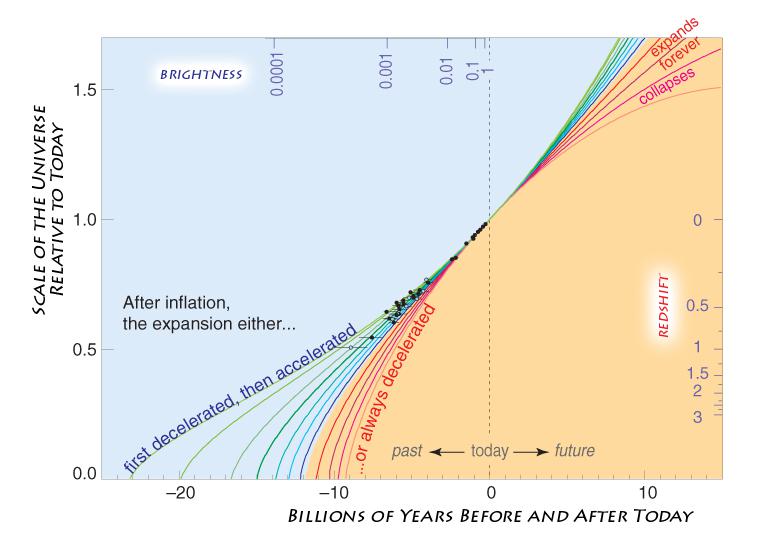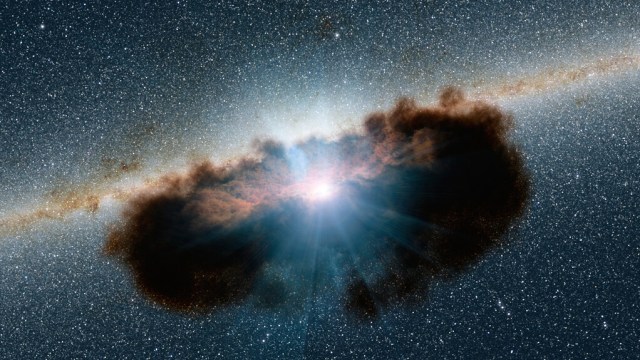Ask Ethan: How can you reason with a young-Earth creationist?

- From a scientific perspective, the evidence is overwhelmingly in favor of a Universe that began 13.8 billion years ago with the onset of the hot Big Bang.
- Yet many continue to reject this conclusion, instead preferring to believe in a Universe that's only ~6,000 years old, a belief system commonly referred to as young-Earth creationism.
- The fact remains, regardless of anyone's beliefs, that science — both the body of knowledge that it's brought us and the scientific process itself — is for everyone.
From a scientific perspective, some of the greatest existential questions that have puzzled humans since the dawn of civilization have, at long last, finally been answered. For as long as we’ve been telling stories, we’ve wondered about questions such as:
- What is the Universe?
- Where did it come from?
- How did it get to be the way it is today?
- And what is its ultimate fate, even far into the future?
During the 20th and 21st centuries, science has provided robustly satisfying answers to these questions, with a suite of overwhelming evidence pointing to the consensus cosmological story. But even though the cosmological standard model is widely accepted by scientists, there are many religious adherents who outright reject the notion of a 13.8 billion year old Universe that began in the aftermath of a hot Big Bang.
What, as a scientist, would you tell those people? That’s what’s essentially being asked, quite provocatively, from a pseudonymous submitter that simply goes by Bgb:
“What does one say to science denying fundamentalist Christians who insist that the universe is only a few thousand years based on back calculating generations in the Bible (or other reasons)?”
I’ve always said and I stand by it that science is for everyone, regardless of what you believe, what your background is, or any other characteristic or history you might possess. That includes young-Earth creationists. If they were open to listening to what I had to say, here’s what I’d tell them.

1.) Science is for you.
This is the first — and arguably, the most important — thing I’d want to impress on anyone: that science is for you, too. No matter what you are, how you identify yourself, or what part of you is most important to you, science is just as much for you as it is for anyone else. Regardless of your:
- race,
- religion,
- country of origin,
- gender,
- language fluency,
- sexual orientation,
or any other factor, property, or trait that you would use to describe yourself, science is for you.
Why is that?
Because science, at its very essence, is simply just the investigation of our physical reality. We all inhabit the same reality; we all arose from within the same reality; we all obey the same laws and rules that nature plays by. There are no exceptions to this, not for any of us, not under any conditions or circumstances that have been probed, experimented with, observed, or measured. We are all entitled to believe as we choose as far as purpose and meaning go, but whenever there are matters that can be decided on their scientific merits, science is the deciding factor.

Take, for example, the statement that “The sky is blue.” You can argue that the sky is red (and sometimes it is, like during certain sunsets), or that the sky is yellow (and sometimes it is, such as when wildfire smoke fills the skies), or that the sky is grey (and sometimes it is, dependent on cloud cover), but when it comes to a clear, sunny day, “The sky is blue” is a scientifically true statement.
How do we know?
Because we can put it to the test. We can study the light that arrives from across the sky in a quantitative fashion, measuring its properties and asking (and answering) key questions like:
- how much light arrives,
- what energy does the arriving light possess,
- how is that energy distributed across the various colors,
- and how does that relate to the property of individual light particles — photons — and the physical properties (like wavelength) that they possess?
When we do, we find that, although light of all wavelengths arrives from the skies, the “bluer colors” arrive preferentially in greater abundances than the “redder colors,” giving the skies their bluish hue.

2.) Science enables you to understand the mechanism by which physically real systems behave.
If you were scientifically curious, you might not only want to know, “is the sky blue?” But you might also want to understand the underlying explanation, and to be able to answer the question, “for what reason is the sky blue?” This is where the power of science truly shines.
All of the Universe, as far as we can tell, is governed by a set of physical laws: rules that apply to all physical systems everywhere across space and time. The reason stars — including our Sun — shine as they do is because they’re hot: these massive balls of matter produce their own energy in their cores through the process of nuclear fusion. That energy, in the form of energetic particles and radiation, exerts a pressure that counteracts the gravitational force, preventing stars from collapsing gravitationally. That radiation bounces around inside the star until it reaches the photosphere, or the very limb of the star, a process that typically takes more than 100,000 years. When it arrives there, it’s radiated away, outward into the Universe.

The properties of that radiation can be calculated, but are mostly dependent only on the mass and size of the star, which determine the rate of nuclear fusion in the star’s core and the surface temperature of the various layers of the photosphere. The relationship between a star’s temperature, brightness, and ionization became very well understood during the 20th century.
When that light arrives at Earth — our home planet — it encounters the Earth’s atmosphere, composed mostly of nitrogen, oxygen, water vapor, argon, carbon dioxide, and a few other gases. The molecules of air that make up Earth’s atmosphere are small, but the wavelength of sunlight is also small, meaning that light and these molecules interact with one another.
Shorter (bluer) wavelengths of light are smaller, and closer in size to the molecules that compose Earth’s atmosphere. Longer (redder) wavelengths are larger, and farther away in size from those atmospheric molecules. As a result, the bluer light gets scattered more easily, getting cast about in all directions. The redder light is more difficult to scatter, as it mostly moves in a straight line. That’s why the sky, particularly in directions away from where the Sun is directly positioned, appears blue, but during sunset, the Sun appears red, as that blue light gets scattered away.

3.) Science provides a method for measurable/observable data, not your preconceived notions, to lead you to a responsible conclusion.
There were lots of other options — and I’ve heard many of them over my life — that could have also explained why the sky is blue. The ocean, for example, is also blue, and some have said the sky is blue because the sky reflects the oceans. A chemistry teacher (!) once explained to me that our atmosphere is 21% oxygen, and oxygen is a light blue gas, and therefore the skies of Earth are blue as well. But neither of these options successfully explains the blue skies of Earth; the scattering of light by molecules is instead the culprit.
It is true that the ocean is blue, but it’s blue because when sunlight travels through the water, the liquid water molecules absorb different wavelengths (i.e., colors) of light at different efficiencies. Water most easily absorbs infrared, ultraviolet, and red visible light; if you dive down to even shallow depths, water, and the objects in it, start to look blue. Go down to deeper depths, and you’ll find that the orange colors get absorbed away as well. At still deeper depths, the yellows, greens, and violets get absorbed. Of all the visible light colors, water is least successful at absorbing blue light. That’s why the oceans appear blue, even from space.

Oxygen, meanwhile, is a completely colorless gas. It’s partially true that it’s blue in color, because if you pressurize and/or cool oxygen sufficiently, it can enter the liquid or solid phase, and in both of those states of matter, oxygen truly is blue. But as a gas, it has no inherent color. Other gases do, mind you: Uranus is blue because the methane in its atmosphere absorbs red light but reflects blue light. Neptune is also blue because of its atmospheric methane, but its lower amount of hazes as compared to Uranus give it a darker blue hue.
The wonderful thing about having a scientific explanation for a process is that, once you understand how a process works, you can apply that understanding to other physical systems. You’d predict that there would be regions of blue sky available outside of the shadow-cone of a total solar eclipse. You’d predict that the Moon would turn red during a lunar eclipse, as the Sun’s red light would still filter through Earth’s atmosphere but the blue light would get scattered away. And you’d predict that shining light through a blue, opalescent material would illuminate the blue color, but that orange/red light would get transmitted through it. Unsurprisingly, all of these predictions are borne out by observation.

4.) Science gives you the same answers, over and over again, regardless of which method you use to arrive at the answer.
This is the primary reason that science is such a powerful tool: because when you ask nature the right questions in the right way about itself, it reveals its secrets to us. If all of our scientific knowledge were somehow wiped out tomorrow — all of it, including all of the data ever taken and recorded about every phenomenon ever to occur on our planet and beyond — we could begin anew. By following the process of science, by asking questions about the world and interrogating the world about the answers through observation, measurement, and experiment, we would swiftly arrive at precisely the same scientific story that we have today.
That’s the remarkable power of science, and the power of the self-correcting scientific process. Science is an empirical enterprise: the data we collect informs the questions we ask; the questions we ask give us relevant data; the additional data allows us to draw replicable conclusions concerning the initial questions; and slowly but surely, we build up a consistent, coherent picture that explains a wide variety of phenomena all under the same umbrella. The more successful a theory or model is at explaining observable phenomena under a broad range of conditions, the greater the scientific validity of that theory or model.

It was probably an inoffensive exercise, for you, to go through this using the example that “the sky is blue.” That’s when science is easy: when it agrees with our intuition for how things ought to work, and when it doesn’t offend our sensibilities, when it falls in line with our common sense and our common experience, and perhaps most importantly, when it doesn’t conflict with what we perceive our core identity to be.
Your core identity probably isn’t wrapped up in the color of Earth’s sky, and it probably also isn’t wrapped up with the explanation behind that phenomenon. If it were, the above line of reasoning would probably have offended you greatly, and would have caused you to find some reason to reject the evidence presented, even though there’s no logical, scientific case against it.
Some people, however, do have their core identities challenged by a scientific finding. Many are unable to accept the laws of relativity, as the notion that space and time are not absolute entities are simply unacceptable to them. Others cannot accept the indeterminate nature of quantum physics: that things like particle locations and trajectories are not objectively determined until a measurement is made. And still others reject:
- the hot Big Bang,
- the science of geology and geophysics,
- or the biological theory of evolution,
all on the basis that they reject the very process of science in determining the answers to questions of our origins: cosmic, planetary, or biological.

My advice to you, if you are one such person, is to consider the following question.
If you did not know, in advance, the answer to a question you can pose, what question(s) would you ask the Universe in order to have it reveal the answer to you?
That’s what you should be asking yourself. If you wonder whether the Earth is flat, think about the decisive questions you can ask — and then go out and test — to deliver the answers to you. If you wonder whether humans have ever landed on the Moon, you can think about how one would test the idea, and then go and collect the critical evidence that settles the issue.
And if you want to know how long human beings have been on Earth, how long the Earth has existed, how old the Solar System is, or how long the (present, observable) Universe has been around, you can learn how to ask the relevant questions that will reveal the answers. As a scientist, my goal in speaking to anyone is not to convince them that the scientific truths I’ve spent my life studying are, in fact, the best answers we have today, although I do view them as the closest approximation of reality we’ve been able to muster. Instead, my goal is to convince you to that, if you want to know the answer to a question that’s answerable by looking to the world or Universe itself, that’s exactly how you should try and find it out!
Send in your Ask Ethan questions to startswithabang at gmail dot com!





